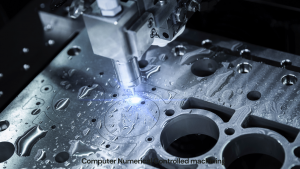CNC -bewerking is voor veel industrieën een perfecte keuze geweest vanwege de vele voordelen. Het belangrijkste doel van dit artikel is om essentiële informatie te presenteren over CNC -bewerkingsroestvrij staal, Benadruk de topprioriteit van de legeringkeuze, en impliceren de noodzaak om het juiste ontwerp van de computerhulp te verwerven (CAD) en computerondersteunde productie (CAM) pakket.
Opgemerkt moet worden dat roestvrij staal uitzonderlijke corrosieweerstand heeft, omdat het een van de meest voorkomende kenmerken van dergelijk materiaal is, En het biedt ook hoge sterkte en de mogelijkheid om de tand des tijds te doorstaan. Het is populair over velden zoals de ruimtevaart , auto -industrie, en de medische en elektronica -industrie. Productie van roestvrijstalen onderdelen met CNC -machines maakt gebruik van een computer om nauwkeurig en ingewikkeld de grondstof vorm te geven en te snijden met geautomatiseerde instrumenten. Deze techniek heeft veel voordelen in vergelijking met andere bewerkingsmethoden waarop conventionele procedures afhankelijk zijn, waardoor het tegenwoordig een populaire methode wordt die door veel fabrikanten wordt gebruikt.
Voordelen van het gebruik van computernumerieke gecontroleerde bewerking op roestvrij staal
Samen met de CNC -bewerkingsapparatuur, precisie, en nauwkeurigheid in de buurt van de limiet van onmerkbaarheid of bijna onmerkbaar zijn de belangrijkste aantrekkelijke kenmerken van het mechanisme. Door computerprogramma's, Machinegestuurde mechanismen kunnen nauwkeurig zijn tot de hoogste mate van precisie, eindelijk garanderen dat een product alle specificaties heeft die het zou moeten hebben. Dit soort nauwkeurigheid is cruciaal, vooral waar je eerlijk gezegd zou verwachten dat elke kleine afwijking kan leiden tot een negatief effect.

Een ander voordeel van CNC -bewerkingsroestvrij staal ten opzichte van handmatige processen is de efficiëntie die CNC -bewerking mogelijk maakt. Het belangrijkste kenmerk van dit proces is de geautomatiseerde aard, wat betekent een hogere productiesnelheid dan handmatige bewerking. Met deze uitstekende tijdbesparende attributen, Snellere productietijd met minder kosten wordt een realiteit.
De toevoeging van CNC -bewerkingsroestvrij staalverhogingen Design veelzijdigheid, te. Het aantal kleine maar extreem fijne vormen gemaakt door computergestuurde machines valt buiten het bereik van traditionele bewerking. Dus, Het opkomende belang van 3D -printen is dat het een revolutioneert van productontwikkeling en innovatie.
In aanvulling, CNC -bewerking heeft een verminderd productieproces, resulterend in kosteneffectieve productie. Hoewel het bestelbedrag voor CNC -machines het bedrijf binnenkort kan schaden, De laatste is gedwongen om een compromis te sluiten en te betalen voor die machines, omdat de voordelen van hen in de rij staan en zwaarder wegen dan hun kosten. Voor CNC -bewerking, Efficiëntie en nauwkeurigheid maken materiaalvermindering mogelijk en minimaliseer de hoeveelheid handarbeid. Als resultaat, De uiteindelijke prijs van de productie kan zo laag mogelijk worden gehouden.
Toplegeringen voor CNC -bewerkingsroestvrij staal
Als het gaat om CNC-bewerking van roestvrij staal, Het selecteren van de juiste legering is van belang van succes van succes. Hier zijn enkele van de beste legeringen die vaak in dit proces worden gebruikt:
- 304 Roestvrij staal:Roestvrij staal is een uitgebreid gebruikte legering van algemene doeleinden. Het vertoont uitstekende corrosieweerstand en veelzijdigheid. Biedt deze functie, die in veel industrieën kunnen worden gebruikt, zoals voedselverwerking en structurele systemen binnen architectuur en auto -onderdelen.
- 316 Roestvrij staal:De 316 Roestvrij staal krijgt zijn uitstekende corrosieweerstand die wordt gecrediteerd aan het feit dat het meestal wordt gebruikt in mariene instellingen waar corrosieve chemicaliën een grote uitdaging zijn. Het is een materiaal van superieure sterkte en duurzaamheid dat kan worden gebruikt voor rigoureuze toepassingen.
- 17-4 PH roestvrij staal: De bekroonde legering werd geselecteerd vanwege de uitstekende hoge sterkte, corrosieweerstand, en goede mechanische eigenschappen. [koperen legering] wordt vaak toegepast op ruimte, verdediging, en medische toepassingen waar [taaiheid en corrosieweerstand] zijn absoluut belangrijk.
- 420 Roestvrij staal:Dit materiaal is uitstekend vanwege de hoge hardheid en weerstand tegen slijtage. Het is bekend dat het werk geweldig maakt en heeft toepassingen die de voorkeursprestaties benadrukken. Bijvoorbeeld, Het wordt gebruikt in chirurgische machines en industriële doeleinden in de geneeskunde.
Ze zijn gebaseerd op verschillende functies en voordelen. Dus, Het selecteren van de ene legering over de andere hangt af van de specifieke eisen voor eindgebruik.
Roestvrijstalen bewerking/numeriek gecontroleerd heeft veel voordelen, zoals enorme kwaliteit en hoge productiesnelheid, de mogelijkheid om verschillende producten tegelijkertijd te ontwerpen, en goedkope productie. Hoewel het waar is dat 3D -printen een aantal voordelen heeft, inclusief lage productiekosten, flexibele montage, en bredere ontwerpvrijheid, Het heeft ook enkele nadelen, inclusief hoge initiële investering, Beperkte materiaalselectie, complexe programmering, en de mogelijkheid van gereedschapsslijtage of breuk.
Geschikte legeringsselectie voor de CNC -bewerking van roestvrij staal is erg belangrijk om de gewenste stekken te krijgen. 304 roestvrij staal, 316 roestvrij staal, 17-4 PH roestvrij staal, En 420 Roestvrij staal zijn de meest populaire familieleden van de legeringsfamilie die bij dit proces betrokken is. Verder, Elke legering heeft zijn unieke eigenschap die hem een taakspecifieke toepassing geeft.
In het algemeen, CNC -bewerking is een proces dat de industriële wereld veel toegevoegde waarde geeft. Door de voor- en nadelen van het gietproces te kennen en een geschikt type legering te selecteren om de producten te produceren, Producenten kunnen hun productie optimaliseren, En hun klanten kunnen producten van hoge kwaliteit gebruiken.
